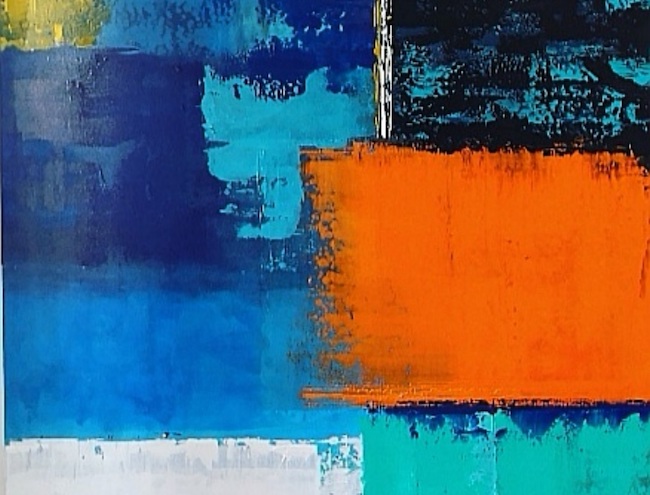Per molti artisti contemporanei dipingere è un gesto interiore, individuale, distaccato da regole definite o legate a movimenti e correnti per muoversi verso una libertà espressiva che li induce a sperimentare, a mescolare e fondere tecniche e stili preesistenti a cui attingere per trovare, proprio nella mescolanza e nella sinergia, un linguaggio personale e fortemente legato alla propria naturale inclinazione, al proprio modo di essere. La protagonista di oggi si pone in profondo ascolto della sua interiorità per narrare attraverso i colori e la tendenza verso la consistenza della materia, il proprio sentire.
Quando intorno alla metà degli anni Cinquanta del Novecento, un gruppo di artisti statunitensi decise di andare contro l’assioma che l’Astrattismo dovesse tenere lontana l’emotività e che l’arte dovesse costituire un atto plastico estraneo alle sensazioni dell’esecutore dell’opera, il mondo della critica e dei maggiori circuiti del mondo dell’arte guardarono con diffidenza e iniziale opposizione quel punto di vista non riconosciuto e distante dalle cosiddette avanguardie ormai accettate come innovazione dell’epoca. Quel gruppo costituì un movimento rivoluzionario, rispondente al nome di Espressionismo Astratto, e si indignò con determinazione a seguito dell’esclusione dalla grande esposizione sull’arte moderna organizzata al Moma di New York, i cui organizzatori non compresero la portata e la forza delle linee guida della corrente di cui Jackson Pollock fu uno dei fondatori, scrivendo ai principali giornali dell’epoca la loro contrarietà alla scelta del grande circuito artistico. Il risultato della vicenda fu una grande eco che condusse gli artisti appartenenti al movimento a essere conosciuti e apprezzati da parte della critica e anche dal grande pubblico che non poté fare a meno di lasciarsi trasportare dalle emozioni che le loro tele suscitavano nell’interiorità dell’osservatore. La libertà stilistica ed espressiva fu uno dei principali dogmi degli appartenenti al gruppo, così come la convinzione che un’opera d’arte non potesse prescindere dall’emozione che l’esecutore provava nel momento del gesto pittorico e che l’osservatore riceveva con la stessa intensità, riprendendo così le teorie tracciate da Vassily Kandinsky ma poi sovvertite e abbandonate da tutti i movimenti pittorici più rigoristi e razionali. Tra i maggiori esponenti dell’Espressionismo Astratto si notano differenze stilistiche ed espressive sulla base della personalità pittorica ma anche della scelta dell’uso del colore dunque si passa dall’Action Painting di Jackson Pollock, per il quale il gesto artistico è un impulso irrefrenabile e privo di ogni controllo da parte della mente né tanto meno gestito in alcun modo da una tecnica prestabilita, al Color Field sereno e meditativo di Mark Rothko per il quale ciascun colore si legava alla sensazione provata nel momento del contatto con la tela e per cui il silenzio e la lentezza sembravano essere imprescindibili per il suo tipo di espressività. Hans Hofman invece si avvalse del Tachisme, cioè di macchie di colore senza ordine logico ma in forte contrasto cromatico per infondere sia il senso di mobilità delle sensazioni interne a ciascun individuo, sia per sottolineare la spiritualità del gesto artistico e per semplificare il linguaggio espressivo permettendo così all’essenziale di fuoriuscire. È esattamente questo il concetto pittorico che appartiene all’artista romana Barbara Monti, fin da bambina in contatto con il proprio lato creativo, supportato e incoraggiato dai suoi genitori, ma anche con la consapevolezza che sia attraverso il cambiamento e la correlazione con popoli e culture differenti che si possa compiere l’evoluzione e sviluppare la capacità di valorizzare la stabilità della propria interiorità, intesa come punto di riferimento attraverso cui è possibile osservare la realtà esterna.
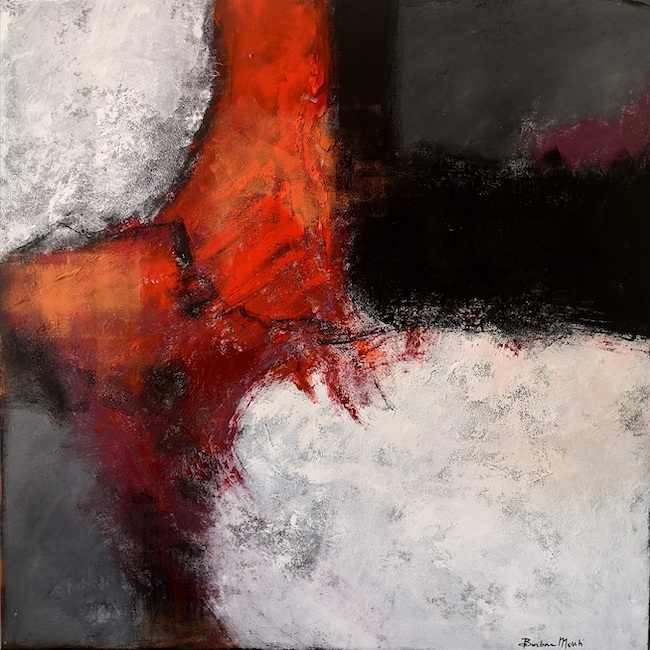
Si sposta a Shangai e a Pechino per approfondire lo studio della lingua cinese e lì entra in contatto con il dinamismo delle grandi città orientali fatte di grattacieli e di corsa verso il progresso e poi, a seguito del trasferimento della sua famiglia in Perù, alle porte dell’Amazzonia, apprende un ritmo di vita opposto, meditato, lento, legato al contatto con la natura; questi due estremi la inducono ad amare da un lato l’esteriorità del vivere che però di contro ha bisogno di essere interiorizzata e accolta nelle profondità interiori che in un secondo tempo si pongono come filtro interpretativo dell’esperienza legata al percorso di vita e al sapore degli eventi e delle circostanze che davanti a quel percorso si presentano.
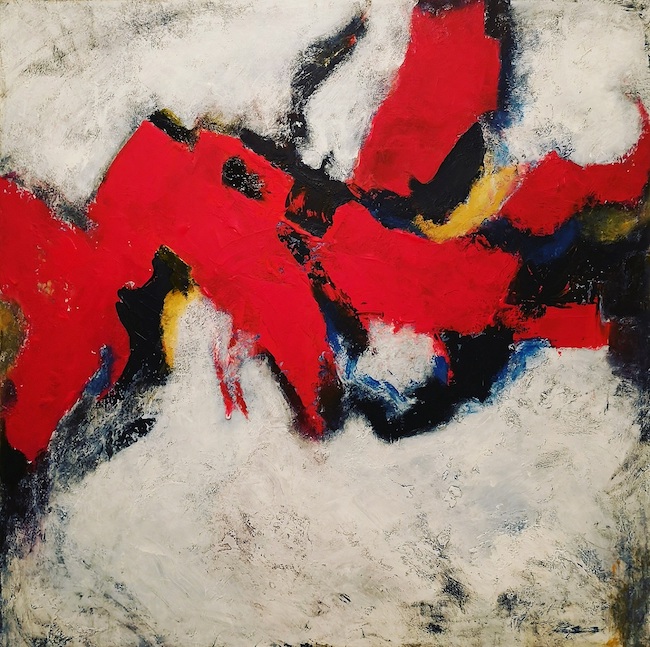
Lo stile di Barbara Monti è fortemente ispirato alle opere di Hans Hofmann sia per l’utilizzo di macchie di colore che vibrano sulla tela in virtù dell’interazione cromatica che si genera, sia per la scelta di tonalità vivaci, intense, a volte più avvolgenti e meditative mentre altre più esuberanti e travolgenti ma sempre di forte impatto emozionale.
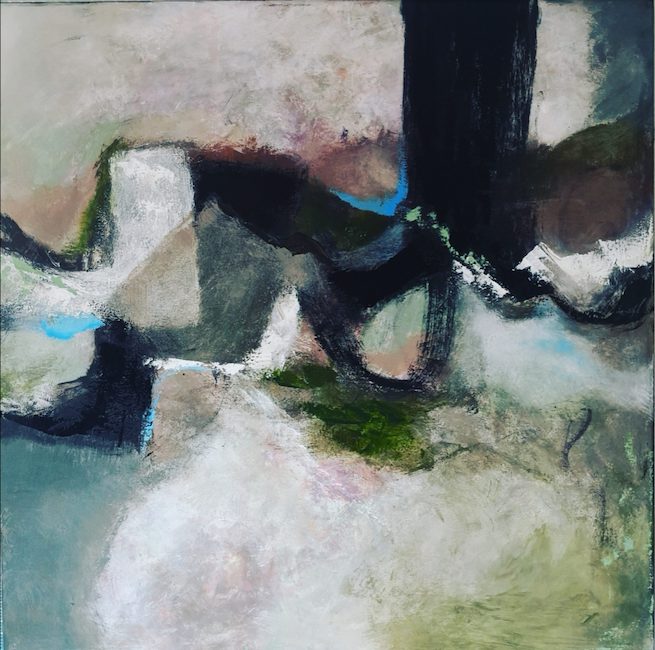
Nella tela Il sentiero nascosto, il cammino di cui racconta il titolo non è materiale, non è effettivo bensì sottintende la lenta spinta verso la conoscenza di sé che appartiene all’essere umano a prescindere dalla consapevolezza della necessità che quel cammino si compia; il contrasto cromatico tra i bianchi polverosi, i neri e la scala di grigi, sottolinea l’alternarsi di luci e ombre, di esperienze negative e positive che appartengono all’esistenza e che determinano il susseguirsi degli eventi così come la crescita personale che ne deriva. L’interiorità della Monti si sofferma su un percorso che le è appartenuto, quella modificazione interiore senza la consapevolezza della quale non avrebbe compreso lati di sé e inclinazioni naturali che invece sono stati evidenti esattamente in virtù dell’attraversamento di quel metaforico sentiero.

Nell’opera Frammenti la gamma cromatica diventa più intensa, si amplia e all’indefinito si affiancano interpretazioni più morbide, grandi macchie pittoriche di colore arancione che rappresentano non solo le possibilità ma anche quei tasselli di realtà che compongono le esperienze, le sfumature esistenziali che vanno a costituire il complesso puzzle della personalità di ciascun individuo; lo sguardo di Barbara Monti è indulgente verso tutto ciò che accade perché piena è la sua consapevolezza che tutto abbia un suo senso che spesso si svela dopo aver superato l’accadimento ed è esattamente in virtù della capacità di guardare oltre l’immediato che tutto assume un significato diverso, è osservando da lontano che è possibile trovare il risvolto positivo anche all’interno di un’esperienza spiacevole.
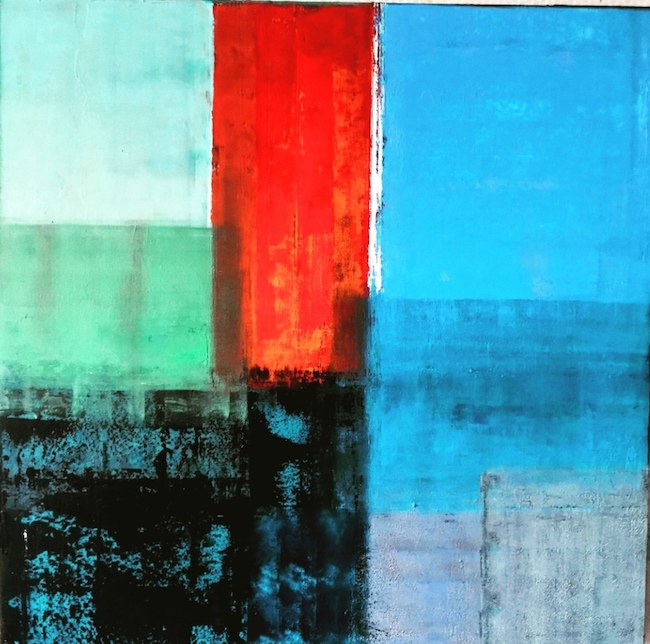
Nella serie di tele Geometrie Blu, a cui appartengono il lavoro Geometrie Blu III e l’opera in copertina articolo, la Monti si avvicina agli echi interiori, al mondo delle possibilità, del sogno, della delicata interiorità che viene scossa e avvolta da intensità inaspettate, da tasselli di passionalità rappresentati dal rosso carminio, dall’arancione intenso, simboleggianti la capacità di apprezzare gli eventi, anche se destabilizzanti, grazie a quell’equilibrio emozionale e interiore raggiunto a seguito di un percorso introspettivo necessario a effettuare l’evoluzione ricercata. Le sensazioni narrate dall’artista sono a volte legate all’osservazione della realtà, altre invece più orientate al suo mondo interiore, eppure in entrambi i casi l’opera diviene un prolungamento della sua spiritualità, dell’interpretazione che lei dà di tutto ciò che le ruota intorno e che viene assorbito solo e unicamente attraverso l’emozione, il vibrare interiore in grado di trasformare l’esterno in una parte di quell’interno morbido e sensibile che si manifesta attraverso il gesto pittorico.
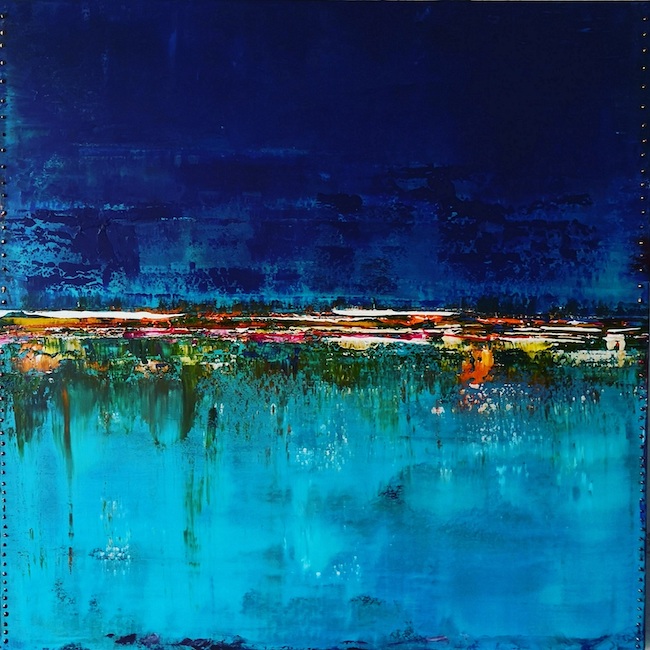
La tela Marocco IV appartiene alle opere in cui l’oggettività si fonde con la componente emozionale, quella provata dall’artista quando ha posato lo sguardo sul panorama che poi ha sentito il bisogno di narrare; la figurazione si mescola all’astrazione generando un inganno visivo all’interno di cui l’immagine diventa una proiezione dell’emozione percepita, una riflessione della piacevolezza del sentire.
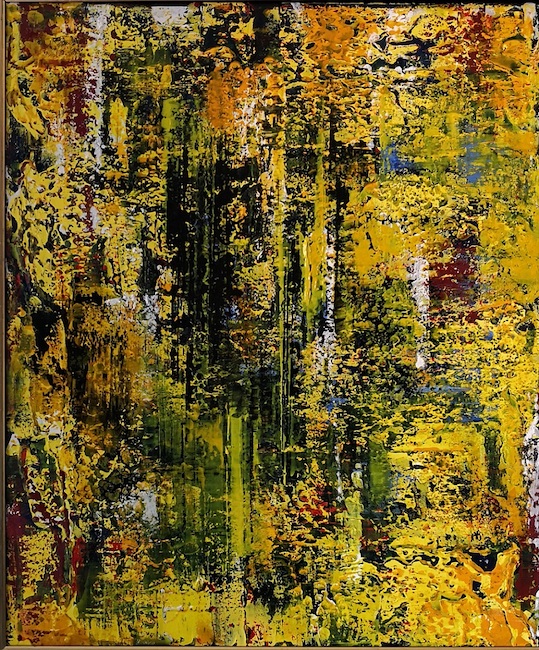
Il desiderio di sperimentazione induce Barbara Monti a utilizzare anche gessi e stucchi su cui stratifica la pittura per entrare in contatto con lo spazio esterno, quasi come se la solidità delle emozioni avesse bisogno di maggiore consistenza, e poi usa le spatole per agire su quelle superfici, per infondere in maniera più incisiva il messaggio che desidera lasciare e far arrivare all’osservatore. Barbara Monti, ha all’attivo molte mostre collettive a Roma e nel Lazio, espone spesso anche nelle collettive dell’Associazione Cento Pittori di via Margutta ed è presente nell’edizione 2021 dell’Annuario dell’Arte Moderna.
BARBARA MONTI-CONTATTI
Email: barbaramonti1974@gmail.com
Sito web: www.barbaramonti.com
Facebook: https://www.facebook.com/barbaramonti74
Instagram: https://www.instagram.com/barbaramontiartist/
The inner vibrations reflected on canvas in Barbara Monti’s Abstract Expressionism
For many contemporary artists, painting is an inner, individual gesture, detached from defined rules or linked to movements and currents, moving towards an expressive freedom that leads them to experiment, to mix and blend pre-existing techniques and styles from which they draw to find, precisely in the mixture and synergy, a personal language strongly linked to their own natural inclination, to their way of being. Today’s protagonist listens deeply to her inner self in order to narrate her own feelings through colours and her tendency towards the consistency of matter.
When, in the mid-1950s, a group of American artists decided to go against the axiom that Abstractionism should keep emotion at bay and that art should be a plastic act unrelated to the sensations of the artwork’s executor, the world of critics and the major art world circuits looked on with diffidence and initial opposition at this unrecognised point of view, which was far removed from the so-called avant-garde movements accepted as innovation of the time. That group constituted a revolutionary movement, with name of Abstract Expressionism, and it was furiously indignant after the exclusion from the major exhibition on modern art organised at the MoMA in New York, whose organisers did not understand the scope and strength of the guidelines of the current of which Jackson Pollock was one of the founders, and wrote to the main newspapers of the time expressing their opposition to the choice of the major art circuit.
The result was a great echo that led the artists belonging to the movement to be known and appreciated by the critics and also by the general public who could not help but be carried away by the emotions that their canvases aroused in the interiority of the observer. Stylistic and expressive freedom was one of the main tenets of the group’s members, as was the conviction that an artwork could not be separated from the emotion that the artist felt at the moment of painting and that the observer received with the same intensity, thus echoing the theories outlined by Vassily Kandinsky but later subverted and abandoned by all the more rigorous and rational painting movements. Among the major exponents of Abstract Expressionism, there are stylistic and expressive differences based on the pictorial personality but also on the choice of the use of colour. Thus, we go from the Action Painting of Jackson Pollock, for whom the artistic gesture is an uncontrollable impulse, devoid of any control by the mind nor managed in any way by a pre-established technique, to the serene and meditative Colour Field of Mark Rothko, for whom each colour was linked to the sensation felt at the moment of contact with the canvas and for whom silence and slowness seemed to be essential to his type of expression. Hans Hofman, on the other hand, used Tachisme, namely patches of colour without logical order but in strong chromatic contrast, to instil both the sense of mobility of the internal sensations of each individual and to emphasise the spirituality of the artistic gesture and to simplify the expressive language, thus allowing the essential to escape.
This is exactly the pictorial concept that belongs to the Roman artist Barbara Monti, who has been in contact with her creative side since she was a child, supported and encouraged by her parents, but also with the awareness that it is through change and correlation with different peoples and cultures that one can achieve evolution and develop the ability to value the stability of one’s own interiority, understood as a point of reference through which one can observe external reality. She moved to Shanghai and Beijing to study the Chinese language in depth and there she came into contact with the dynamism of the great oriental cities made up of skyscrapers and the race towards progress. Then, after her family moved to Brazil, at the gateway to the Amazon, she learned an opposite rhythm of life, meditated, slow, linked to contact with nature; these two extremes induced her to love on the one hand the exteriority of life, which, on the other hand, needs to be interiorised and welcomed in the inner depths that later become an interpretative filter of the experience linked to the path of life and the flavour of the events and circumstances that arise along that path. Barbara Monti’s style is strongly inspired by the paintings of Hans Hofmann, both for the use of patches of colour that vibrate on the canvas by virtue of the chromatic interaction that is generated, and for the choice of lively and intense nuances, at times more enveloping and meditative, and at others more exuberant and overwhelming, but always with a strong emotional impact.
In the painting Il sentiero nascosto (The hidden path), the road of which the title speaks is not material, it is not real but implies the slow push towards self-knowledge that belongs to the human being regardless of the awareness of the need for that path to be completed; the chromatic contrast between the dusty whites, the blacks and the scale of greys underlines the alternation of light and shade, of negative and positive experiences that belong to existence and that determine the succession of events as well as the personal growth that derives from them. Monti’s interiority dwells on a route that has belonged to her, that inner modification without the awareness of which she would not have understood sides of herself and natural inclinations that instead became evident precisely by virtue of crossing that metaphorical trail. In the artwork Frammenti (Fragments) the chromatic range becomes more intense, widens and the indefinite is flanked by softer interpretations, large orange pictorial patches that represent not only the possibilities but also those pieces of reality that make up the experiences, the existential nuances that go to make up the complex puzzle of each individual’s personality; Barbara Monti’s gaze is indulgent towards everything that happens because she is fully aware that everything has its own meaning, which is often revealed after the event has passed, and it is precisely by virtue of her ability to look beyond the immediate that everything takes on a different meaning; it is by observing from afar that it is possible to find the positive side even of an unpleasant experience. In the Geometrie Blu series of canvases, to which the work Geometrie Blu III and the painting on the cover of this article belong, Monti approaches inner echoes, the world of possibilities, of dreams, of the delicate interiority that is shaken and enveloped by unexpected intensities, by pieces of passion represented by carmine red, by intense orange, symbolising the capacity to appreciate events, even if they are destabilising, thanks to that emotional and interior balance achieved following an introspective path necessary to carry out the desired evolution.
The sensations narrated by the artist are sometimes linked to the observation of reality, others more oriented towards her inner world, yet in both cases the artwork becomes an extension of her spirituality, of her interpretation of everything that revolves around her and which is absorbed solely through emotion, the inner vibration capable of transforming the exterior into a part of that soft and sensitive interior that manifests itself through the pictorial gesture. The canvas Morocco IV belongs to the paintings in which objectivity merges with the emotional component, the one felt by the artist when she laid her eyes on the panorama that she then felt the need to narrate; figuration mixes with abstraction, generating a visual deception within which the image becomes a projection of the perceived emotion, a reflection of the pleasantness of feeling. Barbara Monti’s desire for experimentation also leads her to use plaster and stucco on which she layers her paint in order to come into contact with external space, almost as if the solidity of her emotions needed greater consistency, and then she uses spatulas to act on those surfaces, to more incisively infuse the message she wishes to leave and convey to the observer. Barbara Monti, has many collective exhibitions in Rome and Lazio, she often exhibits in the collective exhibitions of the Associazione Cento Pittori di via Margutta and she is present in the 2021 edition of the Annuario dell’Arte Moderna.


